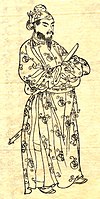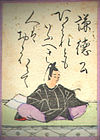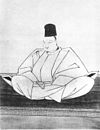|
Sesshō and Kampaku In Japan, Sesshō (摂政) was a regent who was named to act on behalf of either a child emperor before his coming of age, or an empress regnant. The Kampaku (関白) was theoretically a sort of chief advisor for the Emperor, but was in practice the title of both first secretary and regent who assisted an adult Emperor. The duties of the Sesshō and Kampaku were to convey to the Emperor the policies formulated by the Sadaijin (左大臣, Minister of the Left) and other senior officials of the Daijō-kan (太政官, Council of State), and to convey the Emperor's decisions to them. As regents of the Emperor, the Sesshō and Kampaku sometimes made decisions on behalf of the Emperor, but their positions were not defined by law and they had no specific political authority. The two titles were collectively known as sekkan (摂関), and the families that exclusively held the titles were called sekkan-ke (sekkan family).[1] During the Heian period (794–1185), from the middle of the 9th century, the Fujiwara clan began to marry off their daughters to the Emperor and assume the positions of Sesshō and Kampaku, thereby excluding other clans from the political centre and increasing their political power. From the 10th century, the Fujiwara clan monopolized the Sesshō and Kampaku, and at the end of the 10th century, around the time of Fujiwara no Michinaga and Fujiwara no Yorimichi, the power of the Fujiwara clan reached its zenith. In the mid-11th century, Emperor Go-Sanjo ran his own government, and the next Emperor, Shirakawa, abdicated to become Cloistered Emperor, beginning the cloistered rule. From then on, the cloistered rule of Cloistered Emperor took root, and the de facto Fujiwara regime, which used the positions of Sesshō and Kampaku, was over, and the Sesshō and Kampaku lost their real political power and became mere names.[1][2][3] During the Kamakura period (1185–1333), when the warrior class seized power and the Kamakura shogunate was established, the Fujiwara were divided into Five regent houses (五摂家, Go-sekke): the Konoe, Kujō, Nijō, Ichijo, and Takatsukasa families. From then on, these five families served as Sesshō and Kampaku on a rotating basis.[4] Toyotomi Hideyoshi was the first person in history to become a Kampaku who was not a noble by birth; his nephew Toyotomi Hidetsugu also became a Kampaku. Hideyoshi obtained this title, the highest position in the aristocracy, by being adopted into the Konoe family and formally becoming an aristocrat. A retired Kampaku was called Taikō (太閤), which came to commonly refer to Toyotomi Hideyoshi.[5][6] Both sesshō and kampaku were styled as denka or tenga (殿下) in historical pronunciation; translated as "(Imperial) Highness", as were Imperial princes and princesses. HistoryIn earlier times, only members of the Imperial Family could be appointed sesshō. The Kojiki reports that Emperor Ōjin was assisted by his mother, Empress Jingū, but it is doubtful if it is a historical fact. The first historical sesshō was Prince Shōtoku, who assisted Empress Suiko. The Fujiwara clan was the primary holder of the kampaku and sesshō titles. More precisely, those titles were held by the Fujiwara Hokke (northern Fujiwara family) and its descendants, to which Fujiwara no Yoshifusa belonged. In 858, Fujiwara no Yoshifusa became sesshō. He was the first sesshō not to be a member of the Imperial house. In 887, Fujiwara no Mototsune, the nephew and adopted son of Yoshifusa, was appointed to the newly created office of kampaku. In the 12th century, there were five families among the descendants of Yorimichi called sekke: the Konoe family, Kujō family, Ichijō family, Takatsukasa family and Nijō family. Both the Konoe and Kujō families were descendants of Fujiwara no Yorimichi, through Fujiwara no Tadamichi. The other three families were derived from either the Konoe or Kujō families. Until the Meiji Restoration of 1868, those five families held those title exclusively with the two exceptions of Toyotomi Hideyoshi and his nephew Toyotomi Hidetsugu. The offices and titles of sesshō and kampaku were abolished by the declaration of the Imperial Restoration in 1868 during the Meiji Restoration in order to reorganize the government structure. The office and title of sesshō was stipulated under the former Imperial Household Law in 1889 and also under the new Imperial Household Law in 1948. Under these laws, the officeholder of sesshō is restricted to a member of the Japanese Imperial family. Crown Prince Hirohito, before becoming Emperor Shōwa, was sesshō from 1921 to 1926 for the mentally disabled Emperor Taishō. He was called sesshō-no-miya (摂政宮, "the Prince-Regent"). The area of Taikō in Nagoya is named after the title, although it refers to Toyotomi Hideyoshi. The main street is Taikō-dōri, which is served by the subway Taiko-dori Station. ListThe following is a list of sesshō and kampaku in the order of succession.[7] The list is not exhaustive:
See alsoCitations
General references
|







































